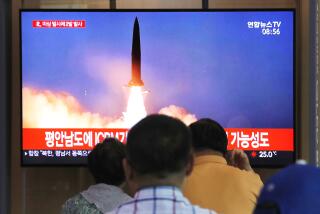‘Superfires’ After Nuclear Attack Could Double Toll
- Share via
STANFORD — An arms expert warned that “superfires” ignited by a nuclear attack on U.S. cities could cause two to four times as many deaths as current government estimates.
Between 36 million and 56 million people would die--far more than the 15 million projected in standard government studies--if one-megaton bombs were dropped on 100 U.S. cities, according to Theodore A. Postol of the Stanford Center for International Security and Arms Control.
Postol, a former adviser on nuclear weapons to the chief of naval operations, said in a speech prepared for an Institute of Medicine symposium at the National Academy of Sciences in Washington that superfires could kill everyone within a six-to-eight-mile radius of ground zero.
Extended Superfire Range
“This enormous increase in projected fatalities is partly a result of the very large expected range of superfires, which extends well beyond that in which large numbers of blast fatalities would be expected, and partly because of the high lethality of the blast-disrupted, fire-swept environments within the burning region,” Postol said.
While deaths would increase, the injured would drop from a range of 22 million to 23 million down to 3 million to 11 million, he said.
The higher ratio of deaths to injuries is in accord with German and U.S. studies of World War II, which showed many more fatalities and fewer injuries when incendiaries were used instead of high explosives, he said.
A one-megaton bomb produces temperatures of about 100 million degrees at its center--four to five times hotter than the center of the sun--and blinding light.
“This intense source of heat and light is capable of setting many simultaneous fires over vast areas of surrounding terrain,” Postol said. “These fires can efficiently heat large volumes of air near the earth’s surface.”
Hurricane-Force Winds
“As this heated air buoyantly rises, cool air from regions beyond the vast burning area would rush in to replace it. Ground-level winds could reach hurricane force, and air temperatures within the zone of fire could exceed that of boiling water.
“The ferocious hurricane of fire would be accompanied by release of large amounts of potentially lethal toxic smoke and combustion gases, creating an environment of extreme heat, high winds, and toxic agents in target areas,” he said.
“An understanding of their effects, and the possible scale of unpredictable consequences that could accompany the use of nuclear weapons in many applications, remains poorly understood, or absent,” from the thinking of planners and decision-makers, he said.
“Without this understanding,” he added, “the probability of misjudgment and miscalculation could be considerable.”
More to Read
Sign up for Essential California
The most important California stories and recommendations in your inbox every morning.
You may occasionally receive promotional content from the Los Angeles Times.













